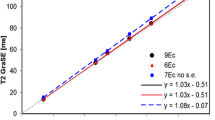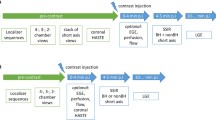Abstract
The aim of this study was to compare the image quality of a saturation-recovery gradient-recalled echo (GRE; TurboFLASH) and a saturation-recovery SSFP (SR-TrueFISP) sequence for myocardial first-pass perfusion MRI. Eight patients with chronic myocardial infarction and 8 volunteers were examined with a TurboFLASH (TR 2.1 ms, TE 1 ms, FA 8°) and a SR-TrueFISP sequence (TR 2.1 ms, TE 0.9 ms, FA, 50°) on a 1.5 T scanner. During injection of 0.05 mmol/kg BW Gd-DTPA at 4 ml/s, three short axis slices (8 mm) of the left ventricle (LV) were simultaneously scanned during breath-hold. Maximum signal-to-noise ratio (SNR), contrast-to-noise ratio (CNR) between infarcted and normal myocardium, and percentage signal intensity change (PSIC) were measured within the LV lumen and in four regions of the LV myocardium for the three slices separately. For the LV lumen, SR-TrueFISP was superior in SNR and PSIC (factor 3.2 and 1.6, respectively). Mean maximum SNR, PSIC, and CNR during peak enhancement in the LV myocardium were higher for SR-TrueFISP compared with TurboFLASH (factor 2.4, 1.25, and 1.24, respectively). The SNR was higher in the septal portion of the ventricle than in anterior/posterior and lateral regions. The SR-TrueFISP provides higher SNR and improves image quality compared with TurboFLASH in first-pass myocardial perfusion MRI.







Similar content being viewed by others
References
Gibbons RJ, Abrams J, Chatterjee K, Daley J, Deedwania PC, Douglas JS, Ferguson TB Jr, Fihn SD, Fraker TD Jr, Gardin JM, O’Rourke RA, Pasternak RC, Williams SV, Alpert JS, Antman EM, Hiratzka LF, Fuster V, Faxon DP, Gregoratos G, Jacobs AK, Smith SC Jr (2003) ACC/AHA 2002 guideline update for the management of patients with chronic stable angina—summary article: a report of the American College of Cardiology/American Heart Association Task Force on Practice Guidelines (Committee on the Management of Patients With Chronic Stable Angina). Circulation 107:149–158
Schwaiger M (1994) Myocardial perfusion imaging with PET. J Nucl Med 35:693–698
Go RT, Marwick TH, MacIntyre WJ, Saha GB, Neumann DR, Underwood DA, Simpfendorfer CC (1990) A prospective comparison of rubidium-82 PET and thallium-201 SPECT myocardial perfusion imaging utilizing a single dipyridamole stress in the diagnosis of coronary artery disease. J Nucl Med 31:1899–1905
Demer LL, Gould KL, Goldstein RA, Kirkeeide RL, Mullani NA, Smalling RW, Nishikawa A, Merhige ME (1989) Assessment of coronary artery disease severity by positron emission tomography: comparison with quantitative arteriography in 193 patients. Circulation 79:825–835
Manning WJ, Atkinson DJ, Grossman W, Paulin S, Edelman RR (1991) First-pass nuclear magnetic resonance imaging studies using gadolinium-DTPA in patients with coronary artery disease. J Am Coll Cardiol 18:959–965
Wilke NM, Jerosch-Herold M, Zenovich A, Stillman AE (1999) Magnetic resonance first-pass myocardial perfusion imaging: clinical validation and future applications. J Magn Reson Imaging 10:676–685
Keijer JT, van Rossum AC, van Eenige MJ, Bax JJ, Visser FC, Teule JJ, Visser CA (2000) Magnetic resonance imaging of regional myocardial perfusion in patients with single-vessel coronary artery disease: quantitative comparison with (201)Thallium-SPECT and coronary angiography. J Magn Reson Imaging 11:607–615
Lauerma K, Virtanen KS, Sipila LM, Hekali P, Aronen HJ (1997) Multislice MRI in assessment of myocardial perfusion in patients with single-vessel proximal left anterior descending coronary artery disease before and after revascularization. Circulation 96:2859–2867
Panting JR, Gatehouse PD, Yang GZ, Jerosch-Herold M, Wilke N, Firmin DN, Pennell DJ (2001) Echo-planar magnetic resonance myocardial perfusion imaging: parametric map analysis and comparison with thallium SPECT. J Magn Reson Imaging 13:192–200
Kraitchman DL, Chin BB, Heldman AW, Solaiyappan M, Bluemke DA (2002) MRI detection of myocardial perfusion defects due to coronary artery stenosis with MS-325. J Magn Reson Imaging 15:149–158
Schmitt M, Mohrs OK, Petersen SE, Kreitner KF, Voigtlander T, Wittlinger T, Horstick G, Ziegler S, Meyer J, Thelen M, Schreiber WG (2002) Evaluation of myocardial perfusion reserve in patients with CAD using contrast-enhanced MRI: a comparison between semiquantitative and quantitative methods. Rofo Fortschr Geb Rontgenstr Neuen Bildgeb Verfahr 174:187–195 [in German]
Wintersperger BJ, Penzkofer HV, Knez A, Weber J, Reiser MF (1999) Multislice MR perfusion imaging and regional myocardial function analysis: complimentary findings in chronic myocardial ischemia. Int J Card Imaging 15:425–434
Plein S, Bloomer TN, Ridgway JP, Jones TR, Bainbridge GJ, Sivananthan MU (2001) Steady-state free precession magnetic resonance imaging of the heart: comparison with segmented k-space gradient-echo imaging. J Magn Reson Imaging 14:230–236
Carr JC, Simonetti O, Bundy J, Li D, Pereles S, Finn JP (2001) Cine MR angiography of the heart with segmented true fast imaging with steady-state precession. Radiology 219:828–834
Barkhausen J, Hunold P, Jochims M, Eggebrecht H, Sabin GV, Erbel R, Debatin JF (2002) Comparison of gradient-echo and steady-state free precession sequences for 3D-navigator MR angiography of coronary arteries. Rofo Fortschr Geb Rontgenstr Neuen Bildgeb Verfahr 174:725–730 [in German]
Hunold P, Brandt-Mainz K, Freudenberg L, Vogt FM, Neumann T, Knipp S, Barkhausen J (2002) Evaluation of myocardial viability with contrast-enhanced magnetic resonance imaging: comparison of the late enhancement technique with positron emission tomography. Rofo Fortschr Geb Rontgenstr Neuen Bildgeb Verfahr 174:867–873 [in German]
Firbank MJ, Coulthard A, Harrison RM, Williams ED (1999) A comparison of two methods for measuring the signal-to-noise ratio on MR images. Phys Med Biol 44:N261–N264
Schreiber WG, Schmitt M, Kalden P, Horstick G, Gumbrich T, Petersen S, Mohrs O, Kreitner KF, Voigtlander T, Thelen M (2001) Perfusion MR imaging of the heart with TrueFISP. Rofo Fortschr Geb Rontgenstr Neuen Bildgeb Verfahr 173:205–210 [in German]
Schreiber WG, Schmitt M, Kalden P, Mohrs OK, Kreitner KF, Thelen M (2002) Dynamic contrast-enhanced myocardial perfusion imaging using saturation-prepared TrueFISP. J Magn Reson Imaging 16:641–652
Muhling OM, Dickson ME, Zenovich A, Huang Y, Wilson BV, Wilson RF, Anand IS, Seethamraju RT, Jerosch-Herold M, Wilke NM (2001) Quantitative magnetic resonance first-pass perfusion analysis: inter- and intraobserver agreement. J Cardiovasc Magn Reson 3:247–256
Schwitter J, Nanz D, Kneifel S, Bertschinger K, Buchi M, Knusel PR, Marincek B, Luscher TF, Schulthess GK von (2001) Assessment of myocardial perfusion in coronary artery disease by magnetic resonance: a comparison with positron emission tomography and coronary angiography. Circulation 103:2230–2235
Zur Y, Stokar S, Bendel P (1988) An analysis of fast imaging sequences with steady-state transverse magnetization refocusing. Magn Reson Med 6:175–193
Barkhausen J, Ruehm SG, Goyen M, Buck T, Laub G, Debatin JF (2001) MR evaluation of ventricular function: true fast imaging with steady-state precession vs fast low-angle shot cine MR imaging—feasibility study. Radiology 219:264–269
Foo TK, Ho VB, Marcos HB, Hood MN, Choyke PL (2002) MR angiography using steady-state free precession. Magn Reson Med 48:699–706
Spuentrup E, Bornert P, Botnar RM, Groen JP, Manning WJ, Stuber M (2002) Navigator-gated free-breathing three-dimensional balanced fast field echo (TrueFISP) coronary magnetic resonance angiography. Invest Radiol 37:637–642
Overall WR, Nishimura DG, Hu BS (2002) Fast phase-contrast velocity measurement in the steady state. Magn Reson Med 48:890–898
Klocke FJ, Simonetti OP, Judd RM, Kim RJ, Harris KR, Hedjbeli S, Fieno DS, Miller S, Chen V, Parker MA (2001) Limits of detection of regional differences in vasodilated flow in viable myocardium by first-pass magnetic resonance perfusion imaging. Circulation 104:2412–2416
Author information
Authors and Affiliations
Corresponding author
Rights and permissions
About this article
Cite this article
Hunold, P., Maderwald, S., Eggebrecht, H. et al. Steady-state free precession sequences in myocardial first-pass perfusion MR imaging: comparison with TurboFLASH imaging. Eur Radiol 14, 409–416 (2004). https://doi.org/10.1007/s00330-003-2176-1
Received:
Revised:
Accepted:
Published:
Issue Date:
DOI: https://doi.org/10.1007/s00330-003-2176-1




